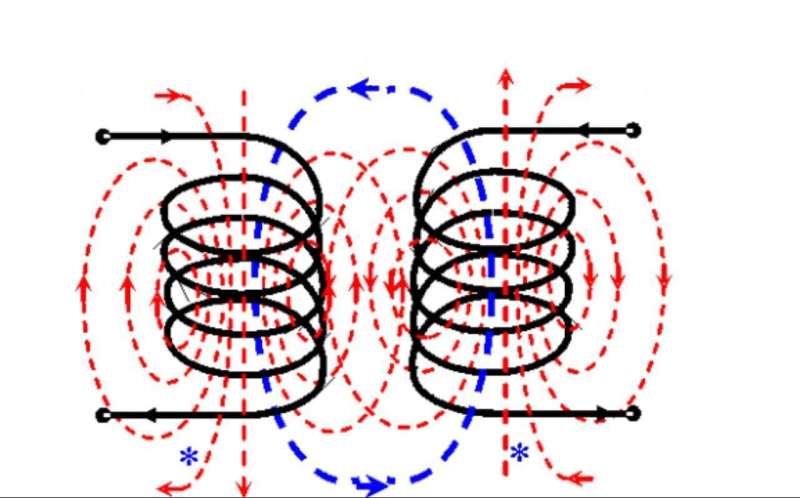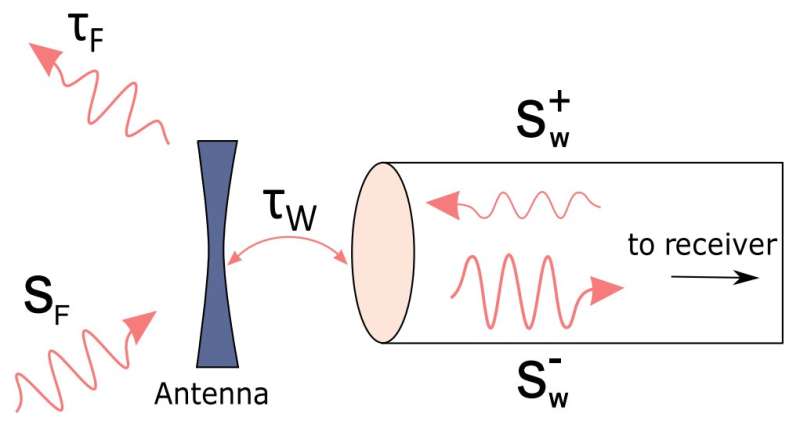Dashed lines of the magnetic fields around two induction coils illustrate the principle of electromagnetic induction. Credit: Alex Krasnok et al./Physical Review Letters
An international research team including scientists from the Moscow Institute of Physics and Technology and ITMO University has proposed a way to increase the efficiency of wireless power transfer over long distances and tested it with numerical simulations and experiments. To achieve this, they beamed power between two antennas, one of which was excited with a back-propagating signal of specific amplitude and phase. The study is detailed in a paper published in Physical Review Letters and briefly reported in the American Physical Society journal Physics.
"The notion of a coherent absorber was introduced in a paper published back in 2010. The authors showed that wave interference can be used to control the absorption of light and electromagnetic radiation in general," says MIPT doctoral student Denis Baranov.
"We decided to find out if other processes, such as electromagnetic wave propagation, can be controlled in the same way. We chose to work with an antenna for wireless power transfer, because this system would benefit hugely from the technology," he says. "Well, we were quite surprised to find out that power transfer can, indeed, be enhanced by transmitting a portion of received power from the charging battery back to the receiving antenna."
Coils and transformers
Wireless power transfer was originally proposed by Nikola Tesla in the late 19th century. He managed to light fluorescent and incandescent lamps from a distance without any wires connecting the lamps to a generator. To pull off this feat, he used the principle of electromagnetic induction: When an alternating current passes through a coil—that is, a conductor wound in a spiral around a cylinder-shaped core—this gives rise to an alternating magnetic field both inside and outside the coil. Faraday's law says that if a second coil is placed in this magnetic field (figure 1), an electric current is induced in this other coil, which can then be used for charging an accumulator or some other purpose.
It may not be obvious, but wireless power transfer is already widely used. For example, unconnected induction coils are at the heart of transformers in television sets, smartphones, energy-saving lamps, power lines, etc. By increasing or decreasing the alternating voltage in the electrical grid and individual devices, transformers enable efficient power transmission and the operation of consumer electronics. Besides that, a technology analogous to that proposed by Tesla has recently been implemented in wireless charging pads for phones and electric cars. Inductive charging starts working the moment an electric car or a phone supporting the technology comes into range.
As of today, however, "in range" means right on top of the charger, and that is one of the main shortcomings of the currently available technology. The problem is that the strength of the magnetic field generated by the coil in the charger is inversely proportional to the distance from it—that is, the field fades quickly with distance. So the second coil, which is built into the device, has to be rather close for a noticeable current to be induced. That is why magnetic cores are used to confine and guide magnetic fields in transformers. And that is also why wireless chargers operate over distances less than 3-5 centimeters. That range could, of course, be enhanced by increasing the size of one of the coils or the current in it, but that would mean stronger magnetic fields potentially harmful to humans around the devices. In most countries, there is a legal limit on radiation power. For example, in Russia, the density of radiation around cell towers cannot exceed 10 microwatts per square centimeter.
Receiving antenna. SF denotes incident radiation, while sw? is the energy that ultimately goes into the electrical circuit and sw+ is the auxiliary signal. Credit: Alex Krasnok et al./Physical Review Letters
Transmitting power over the air
There are other ways of transmitting power without wires that work over longer distances. These techniques, known as far-field energy transfer, or power beaming, use two antennas, one of which sends energy in the form of electromagnetic waves to the other, which then converts radiation into electric currents. The transmitting antenna cannot be substantially improved, because it basically just generates waves. The receiving antenna, by contrast, has much more room for improvement.
Importantly, the receiving antenna does not absorb all of the incident radiation but reradiates some of it back. Generally speaking, antenna response is determined by two key parameters: the decay times τF and τw into free space radiation and into the electrical circuit, respectively. These decay times indicate how long it takes for the amplitude of a wave to be decreased by a certain factor—usually the e number is used. The ratio between these two values determines how much of the energy carried by an incident wave is "extracted" by the receiving antenna. When the two decay times are equal a maximum amount of energy is extracted. If τF is smaller than τw, reradiation begins too early. Conversely, if τF is greater than τw, the antenna is too slow to absorb the incident radiation. When the two times are equal, engineers say that the conjugate matching condition has been met. In other words, the antenna is tuned. Although antennas are manufactured with that condition in mind, achieving absolute precision is quite difficult. Furthermore, even a perfect antenna can easily be detuned due to a change in temperature, signal reflections from the terrain, and other external factors. Finally, the amount of absorbed energy also depends on radiation frequency and is maximized for waves whose frequencies match the resonant frequency of the antenna.
Importantly, the above is only true for a passive antenna. If, however, the receiver transmits an auxiliary signal back to the antenna and the signal's amplitude and phase match those of the incident wave, the two will interfere, potentially altering the proportion of extracted energy. This configuration is discussed in the paper reported in this story, which was authored by a team of researchers featuring MIPT's Denis Baranov and led by Andrea Alù.
Exploiting interference to amplify waves
Before implementing their proposed power transmission configuration in an experiment, the physicists theoretically estimated what improvement on a regular passive antenna it could offer. It turned out that if the conjugate matching condition is met in the first place, there is no improvement whatsoever: The antenna is perfectly tuned to begin with. However, for a detuned antenna whose decay times differ significantly—that is, when τF is several times larger than τw, or the other way round—the auxiliary signal has a noticeable effect. Depending on its phase and amplitude, the proportion of absorbed energy can be several times greater compared with the same detuned antenna in the passive mode. In fact, the amount of absorbed energy can get as high as that of a tuned antenna.
To confirm their theoretical calculations, the researchers numerically modeled a 5-centimeter-long dipole antenna connected to a power source and irradiated it with 1.36-gigahertz waves. For this setup, the dependence of energy balance on signal phase and amplitude generally coincided with the theoretical predictions. Interestingly, the balance was maximized for a zero phase shift between the signal and the incident wave. The explanation offered by the researchers is this: In the presence of the auxiliary signal, the effective aperture of the antenna is enhanced, so it collects more propagating energy into the cable. This increase in aperture is evident from the Poynting vector around the antenna, which indicates the direction of electromagnetic radiation energy transfer.
In addition to numerical simulations, the team performed an experiment with two coaxial adapters, which served as microwave antennas and were positioned 10 centimeters apart. One of the adapters radiated waves with powers around 1 milliwatt, and the other attempted to pick them up and transmit the energy into a circuit through a coaxial cable. When the frequency was set to 8 gigahertz, the adapters operated as tuned antennas, transferring power with practically no losses . At lower frequencies, however, the amplitude of reflected radiation increased sharply, and the adaptors functioned more like detuned antennas. In the latter case, the researchers managed to boost the amount of transmitted energy almost tenfold with the help of auxiliary signals.
In November, a team of researchers including Denis Baranov theoretically demonstrated that a transparent material can be made to absorb most incident light, if the incoming pulse of light has the right parameters (specifically, the amplitude has to grow exponentially). Back in 2016, physicists from MIPT, ITMO University, and the University of Texas at Austin developed nanoantennas that scatter light in different directions depending on its intensity. These may be used to create ultrafast data transmission and processing channels.
More information: Alex Krasnok et al, Coherently Enhanced Wireless Power Transfer, Physical Review Letters (2018). DOI: 10.1103/PhysRevLett.120.143901
Journal information: Physical Review Letters
Provided by Moscow Institute of Physics and Technology
























